ET Group expands into Atlantic Canada with New Fredericton Office
Advancing Coast-to-Coast Coverage as a Premier Workplace Technology & AV Integrator
ET Group – a division of Pistil Enterprises Ltd. – a Toronto-based audiovisual technology company focused on providing workplace technology solutions in Canada, is proud to announce the opening of its new office in Fredericton, New Brunswick, marking a significant milestone in the company’s expansion strategy. This move is a testament to ET Group’s commitment to serving the growing demand for cutting-edge workplace technology and AV solutions in Eastern Canada.
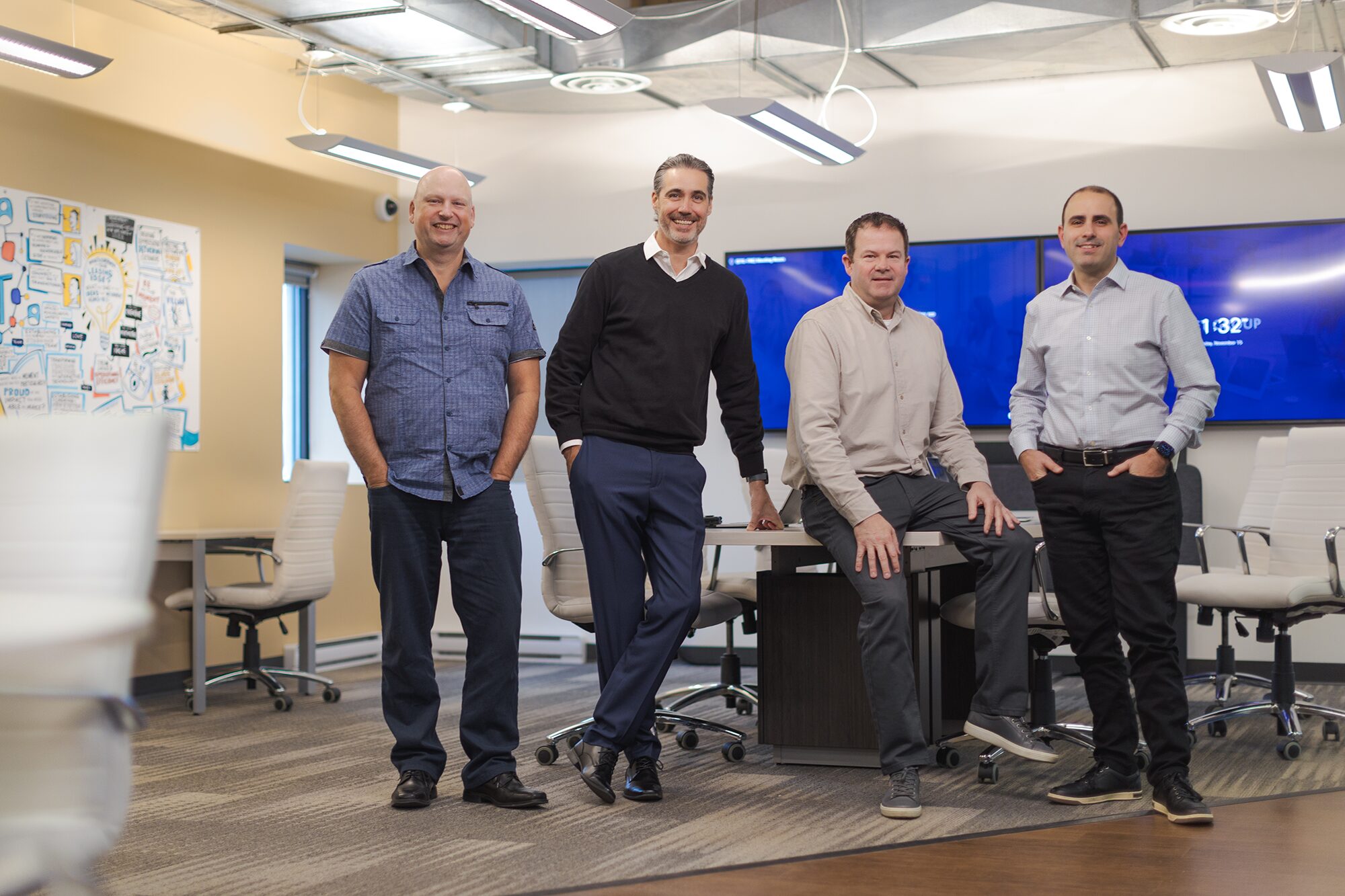
ET Group is thrilled to achieve coast-to-coast coverage as a premier AV and workplace technology integrator, bringing its services to new territories and strengthening its presence in the Atlantic Canada region. The company is dedicated to offering comprehensive consulting, design, integration and support services to customers by connecting businesses with state-of-the-art technology.
“Opening our new office in Fredericton is an exciting leap for ET Group. We are eager to showcase the latest workplace and AV technology to the incredible people of Atlantic Canada. This expansion not only signifies our commitment to innovation but also our dedication to providing top-notch services to our clients in this region,” said Pierre Versteege, Atlantic Canada Account Lead at ET Group.
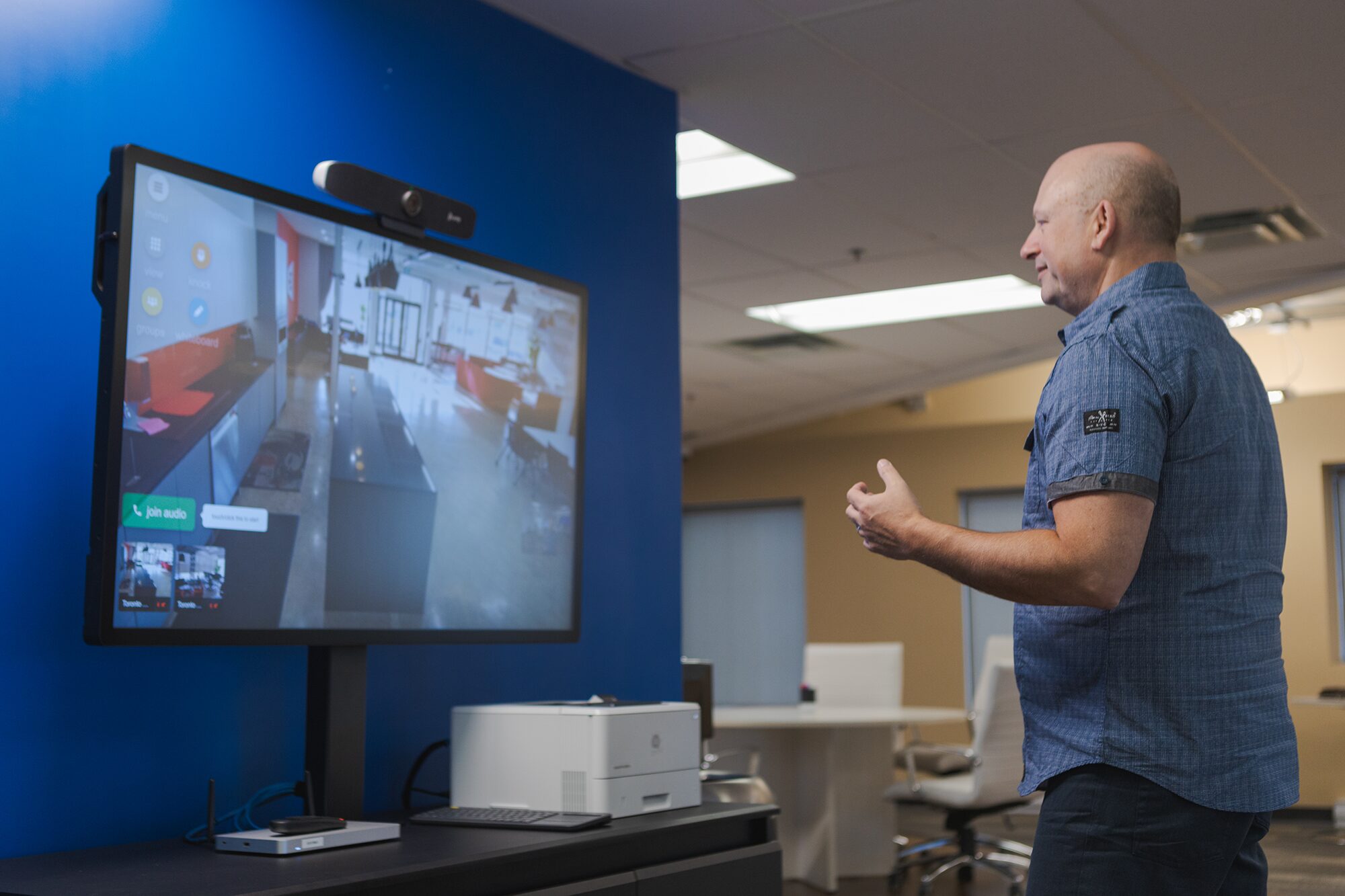
The newly established ET Group office isn’t just a workspace; it’s a cutting-edge demo facility designed to immerse clients in the latest advancements in audiovisual technology. ET Group is excited to invite customers to experience firsthand the transformative power of workplace technology solutions. The demo facility serves as a showcase for innovative workplace and AV technology, allowing businesses to explore tailored solutions that align seamlessly with their unique needs. Pierre Versteege (Account Lead) is eager to personally guide clients through this immersive experience. If you’re interested in discovering how our state-of-the-art technology can elevate your business, don’t hesitate to reach out to Pierre Versteege by filling out the contact form on the ET Group website.
“We are ecstatic about what this means for us, our clients, and the Canadian AV industry. This new office will allow us to enhance our national coverage, provide a wider range of the industry’s best managed services, and access ET Group’s services to help our clients navigate new ways of working, ” said Dirk Propfe, President & CEO at ET Group.

The Fredericton office represents a strategic move towards expanding its reach, one province at a time, and enhancing communication through technology. As a trusted partner for AV needs, the company is well-positioned to deliver expert audiovisual integration services to businesses across Eastern Canada.
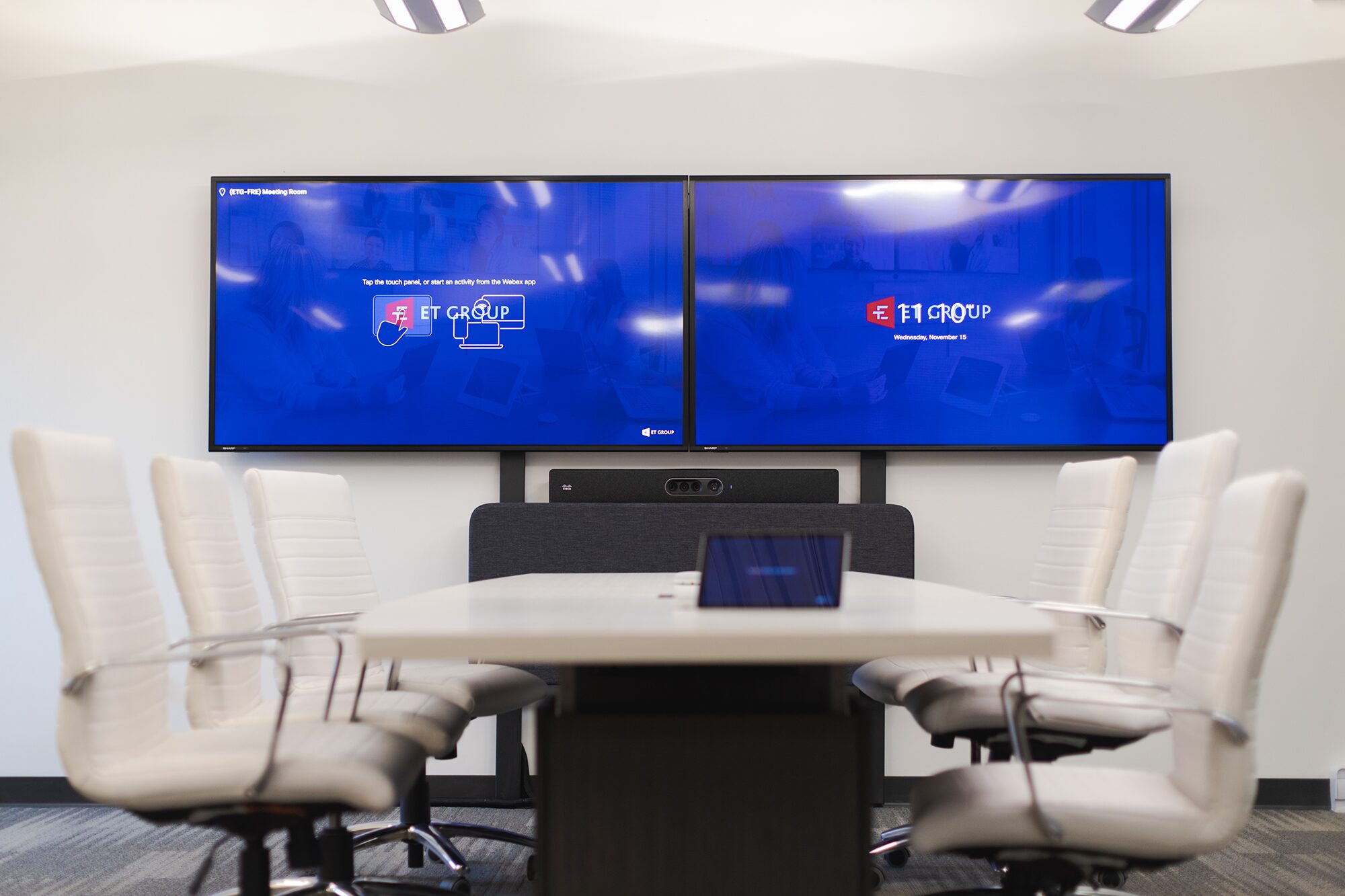
About ET Group
ET Group – a division of Pistil Enterprises Ltd. – is a Toronto-based audiovisual technology company focused on providing workplace technology solutions in North America. Alongside its design and integration expertise, ET Group provides top-tier service and support, as well as learning experiences to coach clients on new hybrid work practices. For 45 years, the company has helped its clients tackle their evolving and complex communication and collaboration challenges by providing workplace technology solutions that support their unique needs.
For inquiries and further information, please contact:
Pierre Versteege, Account Lead — Atlantic Canada
pversteege@etgroup.ca
The barriers to hybrid collaboration that sit beneath the surface
To find out why companies are struggling with hybrid collaboration, ET Group teamed up with WORKTECH Academy to run a workshop on common challenges. The results shine a light on social and cultural challenges
Reposted article from WORKTECH Academy
It’s one of the most conspicuous and most talked-about challenges in the emerging world of flexible work – how to give everyone hybrid meeting equality so all employees enjoy a high-quality collaborative experience irrespective of whether they have joined remotely or are attending in-person at the office.
Companies are aware of the issue and willing to experiment to find solutions, but they’re finding that they face an uphill struggle. Despite their best efforts, neither investment in new technology nor redesign of meeting space – the two reflex responses to the challenge – are really moving the dial.
So, are we missing something here? Canadian workplace technology designer and integrator ET Group, which is working on digital communication projects with a range of large clients in North America, believes we are.
In essence, ET Group’s experience suggests that the issue of meeting equality is not independent from what’s going on beneath the surface of the company. While the technology and spatial aspects of hybrid meetings matter, the social interactions and beliefs that underpin the structure of an organisation – termed organisational paradigms – could well matter more.
‘The social interactions and beliefs that underpin the organisation could well matter more…’
ET has teamed up with WORKTECH Academy to produce an article series to explore the dimensions of achieving digital equity.
In our first article, ET Group CEO Dirk Propfe and Senior Consultant Stephan Berchtold presented a model for why so many companies get stuck, illustrated with a theoretical model to explain the company’s thinking. This has four main pillars: technology; place/space; social interaction; and organisational paradigms.
In this second article, we report here on an international workshop facilitated online by ET Group and WORKTECH Academy to explore the barriers to hybrid collaboration using ET Group’s four pillars model. Workplace professionals from more than 30 companies in different industries and with different perspectives took part in the workshop on 23 August 2023. Drawn from the Academy’s network, they shared insights and ideas on the topic.
How was the workshop conducted?
Early in the workshop we asked the participants to share the barriers to hybrid collaboration they or their teams encounter. This was done in a crowd-sourcing exercise with small breakout-groups of up to four people. This crowd sourcing did not have any predefined categories, just a blank canvas to collect whatever barriers came to mind. Only further into the workshop the four pillars were introduced and explained.
What did we learn?
After the workshop we unpacked the crowd-sourced barriers and mapped them to the four pillars model. The findings were very much in alignment with the distribution that ET Group is experiencing time and again: In the workshop, only 19 per cent of the barriers related specifically to technology and hardly any related to the place where people work.
Just as ET Group had predicted, based on its research and observation, the vast majority related to social interaction or organisational paradigms or some combination of both; 80 per cent of the barriers qualified for these categories. More than one in four barriers (43 per cent) reflected difficulties with social interaction alone.
‘Participants said that hybrid meetings provided no space to socialise or build relationships’
There were, of course, issues with unreliable technology, poor sound and video quality, and the difficulties of navigating multiple tech tools – all impeded hybrid collaboration. Home office set-ups were troublesome and, generally, technology needed to be more user friendly, especially to overcome resistance among older workers. The place-based collaborative experience could also be difficult if people were spread out too thinly within the office environment.
But, to use an iceberg analogy, these above-the-surface barriers were dwarfed by factors hidden beneath the waterline.
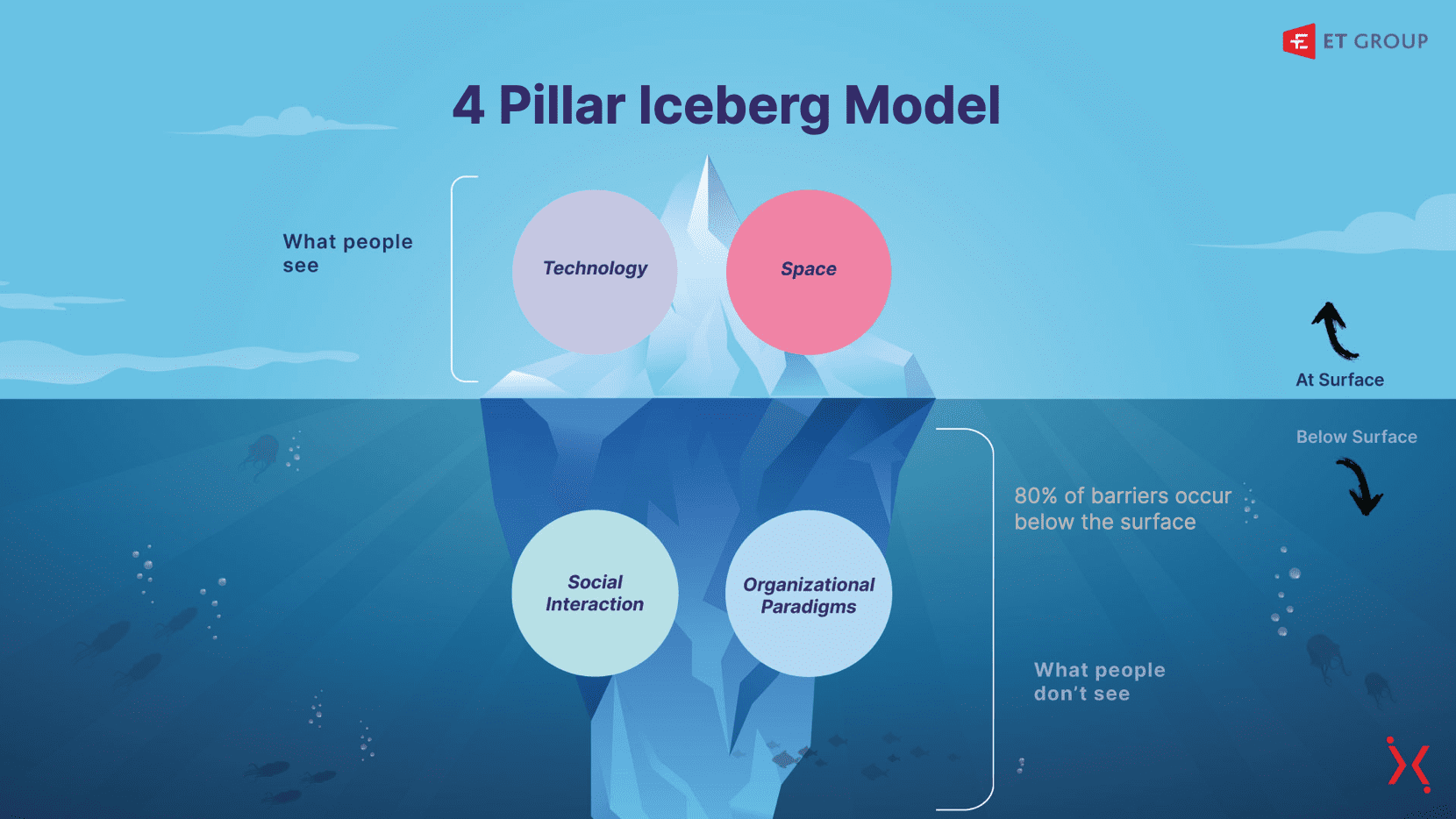
Social Interactions
ET Group defines social interactions in an organisation as ‘the various ways in which individuals in the workplace engage and communicate with one another on professional and personal levels. These interactions can take place both formally and informally, and they encompass a wide range of activities, from casual conversations during breaks to collaborative teamwork, meetings, networking events and team-building activities’.
Social interaction barriers included lack of socialisation and getting a chance to know each other, and people talking over each other all the time during meetings as visual cues are lacking. The findings also contained aspects such as cameras being turned off, thus adding to a perceived distance, as well as people feeling stressed out by being on camera all day.
Scheduling conflicts (especially with regards to not owning the calendar or lack of flexibility to have time for individual working blocks), time zone challenges, meeting distractions (children, pets etc.), lack of attention and lack of engagement were problematic. Participants also said that hybrid settings often provided no space or time to have more creative discussions or do anything unpredictable or spontaneous.
All these findings point to one direction: we need to better understand how to enable social interaction in remote or hybrid settings. We need to find ways to create the best value from being in different environments, where hybrid will be – to a greater or less extent – part of our organisations, i.e. our social systems. This puts some responsibility on those in charge of creating environments where social interaction is supported – not just building architects and technology designers, but also organisational leaders, as well as the training programmes in which they get their education for these roles.
Organisational paradigms getting in the way of better hybrid collaboration centred on resistance to learn new ways (and tools) of working, and a lack of trust by senior leaders. There appeared a discord and a generational divide between employees and their company leaders that no amount of great tech or office design could bridge. Such barriers ran deepest, which is why the problem of digital equity has been such a tough nut to crack.
Organisational paradigms
ET Group defines organisational paradigms as ‘the fundamental beliefs, assumptions and mental models that shape the structure, culture and overall approach to conducting the business of the organisation. These paradigms are the underlying framework or perspectives that influence decision making processes, organisational behaviour, and the way work is performed within the company’.
These findings point to a crucial aspect: our organisations are built on assumptions of how things are done, which have become largely non-negotiable over time. Yet this fact does not make it true. For instance, the assumption that human beings are lazy, and need to be controlled and directed, is directly contradicted by a large body of research about human behaviour and our intrinsic and extrinsic motivations. Control mechanisms at work lead to an operational system that is rigid and inflexible; as a result, many of the formal and social interactions in the workplace are based on a lack of trust, which results in not giving autonomy.
ET Group provided a simple analogy in the workshop for an organisational paradigm by comparing a traffic light junction with a roundabout as different ways to manage the flow of traffic. The former is a highly technical solution that takes the decision-making away from the individual. The latter involves less technology, relies on a minimum of rules, and trusts that people will work it all out.

To be clear: as we know from long-distance relationships, it is a special challenge to keep those interactions up and running to sustain the bond. In terms of organsations, it is clear that if there is not sufficient and meaningful interactions among the people, the social system will evaporate. So, it is also reasonable that leaders must strive to keep the system alive. The crucial thing is how they do it. And if the old map we have used for decades is the only map forward, they might well find themselves lost.
Lack of serendipitity
Insights from the crowd sourcing workshop also emerged at the intersections between the four pillars, revealing some interesting paths forward that companies might take. For instance, intersecting between social interaction and technology) raised the need for digital knowledge and upskilling so that people struggle less. There was concern about a lack of serendipitous collaboration as well as the inability to have a quick chat with someone separately after a meeting. And there were a host of issues aired that centred on changing corporate behaviour and building a better understanding of employees. It was felt that hierarchies were more entrenched in online conversations, making it harder for junior team members to speak.
Based on insights from the workshop, ET Group is continuing to evolve its recommendations to support companies on their journey to improve hybrid collaboration.
An additional framework, which leverages the value from the ‘four pillars’ model will be shared by Dirk Propfe of ET Group at the WORKTECH Toronto conference on 23 October 2023 and discussed in the next article in this WORKTECH Academy series. As Dirk Propfe explains, ‘As technologists, it’s important that we get to the human elements of the hybrid experience.’
ET Group is a Corporate Member of WORKTECH Academy. This article is the second in a series on hybrid meetings and the search for digital equality. The Four Pillars model has been developed by ET Group based upon its own experience transforming into a highly innovative and highly distributed team for nearly a decade. ET is now sharing the strengths and challenges of its distributed hybrid work experience with clients through programs and workshops.
Dispelling 5 Major Myths About Hybrid & Remote Work
Summary:
- Remote workers often have equal or even higher productivity levels than in-office workers, benefiting from reduced distractions and no commuting.
- While remote work can lead to feelings of isolation, strategies like regular check-ins, virtual team-building, and hybrid meeting solutions can combat this.
- Security concerns in remote work can be addressed through tools like VPNs, regular cybersecurity training, Multi-Factor Authentication, and endpoint security.
- The world of work is transitioning, with hybrid and remote work becoming standard in many industries. Organizations should take a proactive approach and invest in the right technology to help them reap the benefits.
- Hybrid work technology can improve collaboration, increase productivity, provide cost savings, and attract a wider talent pool. Contact ET Group to learn more about how to make the transition for your workplace.
Modern workplaces continue to evolve, but so do certain misconceptions about hybrid and remote work. When left unaddressed, these misconceptions can deter organizations from making the leap to more flexible and productive hybrid work environments.
Fortunately, our team at ET Group is well-versed in the truths and myths surrounding hybrid and remote work, and we’re here to help you understand the difference so you can make confident choices about upgrading your technology and providing a better experience for all of your team members. Join us below as we tackle three particularly major misconceptions regarding productivity, loneliness, and security.

Remote Work & Productivity
The Myth
One of the most prevalent myths surrounding remote work is that it leads to reduced productivity. The concern is that without the direct oversight of management and the structured environment of an office, employees tend to slack off.
The Reality
Contrary to this belief, numerous studies have found that remote workers often have equal or even higher productivity levels than their in-office counterparts. For instance, productivity among workers who shifted to remote work during the COVID-19 pandemic actually increased by 47% compared to the previous year’s metrics.
Why is this the case? Many remote workers benefit from:
- Reduced distractions
- No commuting times
- The flexibility to design their work environment in a way that best suits their productivity needs
These benefits can be experienced even further by creating custom hybrid spaces where your remote team members can collaborate seamlessly with your on-site personnel, ensuring the flow of ideas and tasks are uninterrupted.
Employee Isolation & Loneliness
The Myth
Another myth posits that remote work leads to employee isolation and loneliness, considering workers are physically removed from their colleagues.
The Reality
While the risk of feeling isolated exists, proactive strategies can effectively combat this challenge. Here’s how:
- Regular Check-ins: Managers can schedule regular check-ins to discuss not just work but also personal well-being. These one-on-ones can foster a closer bond between the employee and the organization.
- Virtual Team Building: From virtual coffee breaks to online team games, there are myriad ways teams can stay connected and engaged.
- Hybrid Meeting Solutions: Investing in advanced audiovisual technology can help make virtual meetings as interactive and engaging as in-person ones. Tools that facilitate real-time collaboration, screen sharing, and high-definition video conferencing can bridge the gap between remote and on-site team members.
See Also: Designing Conference Rooms that Work For Today’s Offices
Security & Confidentiality Issues
The Myth
Many businesses fear that allowing employees to work remotely can compromise the security and confidentiality of company data.
The Reality
What many organizational leaders don’t realize is that hacking and malware account for far fewer breaches than simple human error (which remains the top cause). So while security concerns are certainly legitimate, businesses can still ensure a high level of data security by implementing a few key tools and strategies:
- VPN & Encrypted Connections: Using Virtual Private Networks (VPNs) and ensuring encrypted connections can provide a secure online environment for remote workers.
- Regular Training: Employees should be regularly trained on cybersecurity best practices. This includes recognizing phishing attempts, securing their home networks, and following proper protocol when accessing company data.
- Multi-Factor Authentication (MFA): MFA adds an extra layer of security by requiring multiple forms of verification before granting access.
- Endpoint Security: Ensuring that all devices, including personal ones used for work, have the latest security patches and anti-malware software installed.
Collaboration & Innovation
The Myth
Another common myth around the hybrid work model is that it hampers collaboration and stifles innovation. The fear is that the creative energy generated through in-person interactions will be lost when teams are distributed across different locations.
The Reality
While it’s true that in-person interactions can sometimes support spontaneous and valuable collaborations, the notion that hybrid work inherently stifles innovation is incorrect. In fact, a well-managed hybrid environment actually promotes creativity and collaboration. Here’s how:
- Flexible Brainstorming: Hybrid work models offer the flexibility to schedule focused, in-person brainstorming sessions when needed, while still allowing individual team members the freedom to work remotely for tasks that require deep concentration.
- Diverse Perspectives: Remote work often means a more diverse workforce, as companies can tap into talent pools that aren’t geographically limited. A team with diverse experiences and viewpoints can enrich creativity and contribute to more innovative solutions.
- Digital Tools for Collaboration: A wide array of collaboration tools like Slack, Microsoft Teams, and Google Workspace offer features for real-time collaborative work, from text and video chats to digital whiteboarding.
- Time-Shifted Collaboration: In a remote or hybrid work environment, not all team members need to be online at the same time to collaborate. The asynchronous nature of many digital tools allows for “time-shifted” collaboration, which can actually improve the quality of input and feedback.
Company Culture
The Myth
Another misconception surrounding the hybrid work model is that it erodes organizational culture. Some believe that without daily physical interactions, the shared values, rituals, and practices that make up a company’s culture can start to fade away.
The Reality
The building blocks of organizational culture are not restricted to a physical location. While it may be challenging to replicate the “water cooler” moments of an office environment, a strong culture can be nurtured in a number of different ways:
- Virtual Team-Building: Regularly scheduled virtual events such as game days, happy hours, or team lunches can help reinforce your team’s sense of unity and shared purpose.
- Clear Communication: Transparent two-way communication from leadership about your company’s goals, values, and milestones can help build a cohesive culture, even when the workforce is scattered.
- Shared Digital Spaces: Platforms that serve as an online “office” can host team updates, achievements, and even casual chat rooms that resemble office encounters. Well-designed hybrid spaces will be essential for supporting company culture as more organizations embrace remote work.
- Cultural Ambassadors: Designate team members as ‘cultural ambassadors’ who are tasked with maintaining team cohesion and culture. They can be pivotal in organizing virtual team-building activities and ensuring that new members assimilate into the existing culture efficiently.
Adapting As the World Embraces Hybrid & Remote Work
The world of work is undergoing a significant transformation—so the question isn’t whether you should adapt; it’s how you’ll need to in order to keep thriving. Organizations that are willing to move past misconceptions and invest in the right technology will find themselves better poised to harness the benefits of hybrid and remote work as it becomes the new standard for an increasing number of industries.
The key is to understand what legitimate challenges exist when pivoting towards hybrid work, and what concerns are unfounded. Learn more about how to transition to a hybrid work environment effectively by contacting our team at ET Group, or browse the FAQ below.
Frequently Asked Questions about Hybrid & Remote Work
What specific benefits can hybrid work technology bring to my organization?
Hybrid work technology offers a wide range of benefits to businesses to embrace its possibilities, including:
- Improved Collaboration: Hybrid work technology fosters better collaboration between remote and on-site team members.
- Increased Productivity: This enhanced collaboration often leads to heightened productivity levels.
- Cost Savings: Organizations can experience savings related to real estate and utilities.
- Attracting Talent: The flexibility offered by hybrid models can attract a broader range of talent who prioritize flexible work options.
Are there any hidden costs to consider when transitioning to a hybrid work model?
Apart from the apparent technology and training investments, organizations might face costs related to:
- Changing company culture
- Technology maintenance
- Software subscription renewals
However, many of these are offset by the long-term savings and benefits hybrid work offers.
What steps should my organization take to prepare its workforce for the transition to hybrid technology?
Key steps include:
- Communicating the reasons behind the change
- Providing ample training opportunities
- Gathering feedback during the transition
- Being open to iterative improvements based on challenges faced
Consider additional training to help your team acclimate as you move towards a hybrid model. ET Group’s workshops can provide your organization with tools and strategies designed to reduce friction during this process.
How can my organization address concerns about hybrid technology?
Open communication is key. Address concerns by presenting data on the benefits, involving employees in the decision-making process, and providing platforms for feedback. Moreover, pilot programs can be launched to test and showcase the effectiveness of the technology.
See Also: Managing Your Hybrid & Remote Workers
Are there any industries where hybrid or remote work isn’t feasible?
While many industries can adopt hybrid models, some roles, especially those requiring specialized equipment or hands-on tasks (e.g., healthcare or manufacturing), might still find it challenging. However, as automation and audiovisual technology both become more advanced, a growing number of industries are likely to support hybrid work, so it’s always worth considering how you can become an early adopter and stay ahead of the curve.
Stay connected with us:
Follow ET Group on LinkedIn
Follow us on Twitter
Subscribe to ET Group’s YouTube Channel
6 tips for more inclusive hybrid & remote meetings
In an ever-evolving landscape of remote work and digital collaboration, the traditional concept of meetings has undergone a significant transformation. The emergence of hybrid meetings – a blend of in-person and virtual interactions – has introduced a new paradigm in how teams communicate, collaborate, and innovate. However, despite the convenience they offer, many of us have experienced the sense of disconnection that often accompanies hybrid meetings. This is where a pioneering approach aims to change the game.
Imagine walking into a meeting that feels less like a monologue of updates and more like a dynamic conversation where every participant’s voice is not only heard but valued. Envision tackling critical business challenges collaboratively, irrespective of physical location, and leaving the meeting with a renewed sense of purpose and inspiration. This vision isn’t just a distant dream; it’s the future that our team is actively crafting.
Tip #1: Set the Stage for Connection
Let’s start by shifting our mindset from monologue to dialogue. When you step into a hybrid meeting, consider it a chance to engage in a conversation, not just passively receive updates. Kick off the meeting with a check-in, where everyone shares their thoughts, feelings, and expectations. This simple practice immediately creates a sense of connection and sets a collaborative tone for the session.
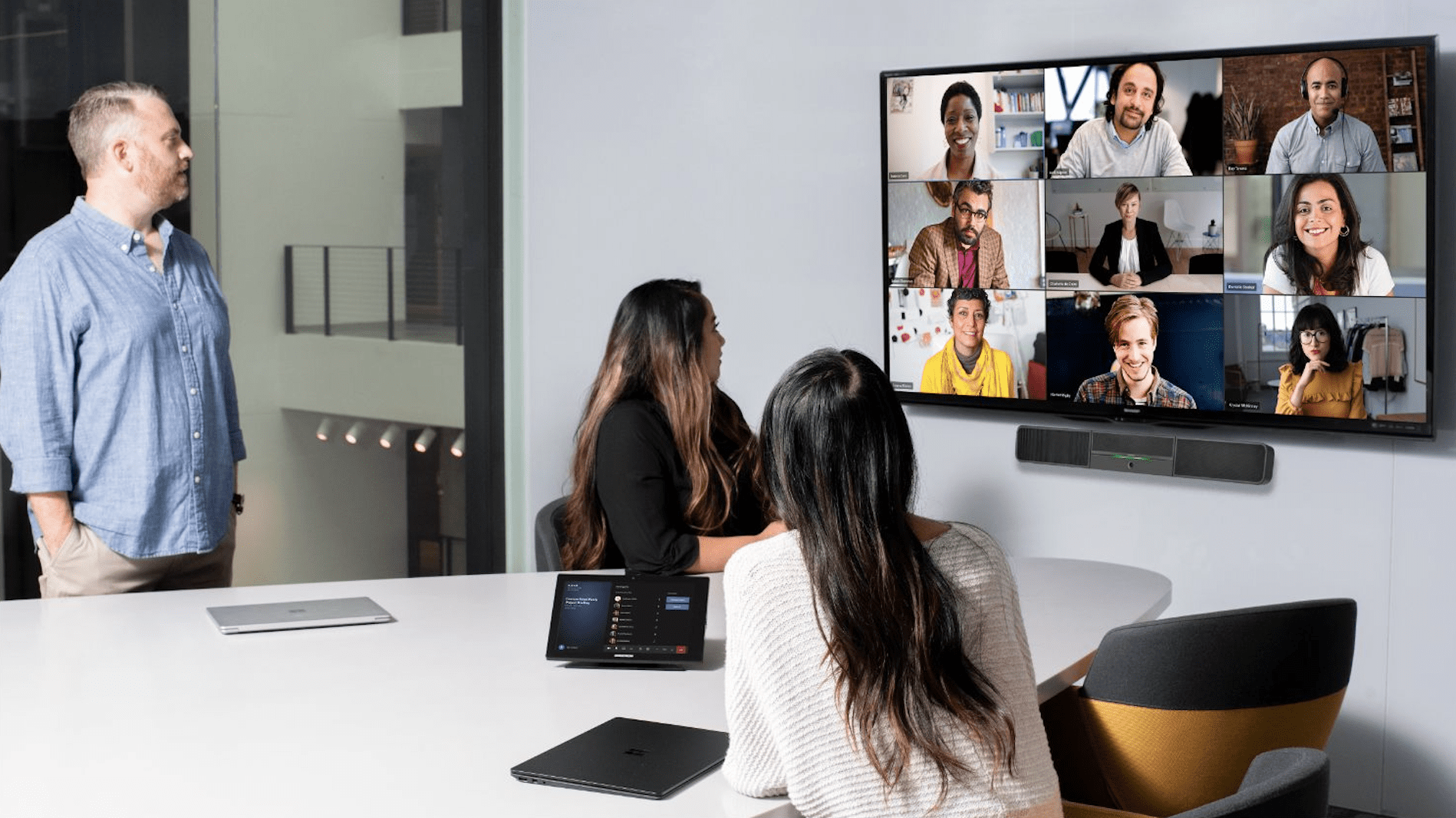
Tip #2: Embrace Collaborative Technology Tools
Technology is the backbone of successful hybrid meetings. But it’s not about flashy gadgets; it’s about tools that enhance your interactions. Look for seamless, user-friendly technology solutions that enable real-time collaboration. These tools should allow participants to interact with content and with each other, regardless of their physical location. An interactive whiteboard, virtual breakout rooms, and live polling are just a few examples that can transform passive listeners into active contributors.
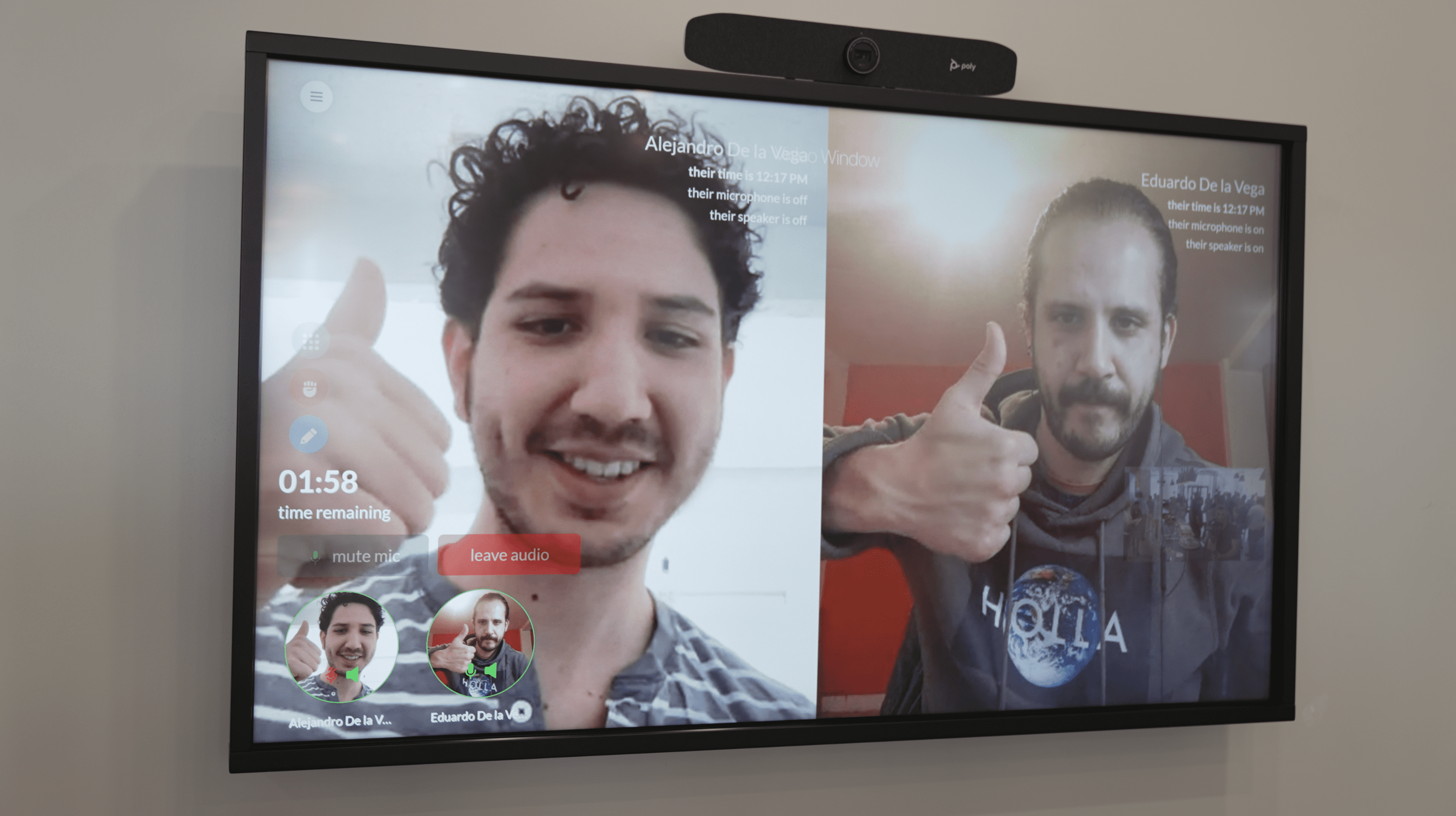
Tip #3: Keep It Engaging
Long gone are the days of endless presentations. Keep your hybrid meetings engaging by integrating various formats. Mix in short presentations with discussions, brainstorming sessions, and problem-solving exercises. Encourage everyone, whether in the room or on the screen, to participate actively. Remember, engagement breeds connection, and connection fuels productivity.

Tip #4: Value Every Voice
In a hybrid setting, it’s crucial to ensure that every voice is heard. Create an environment where all participants, regardless of their location, feel valued and included. Prioritize inclusivity by using collaborative tools that allow remote participants to contribute just as easily as those in the room. When everyone’s perspective is acknowledged and considered, you’re likely to arrive at more well-rounded solutions.
Tip #5: Foster Meaningful Wrap-Ups
As you wrap up your hybrid meetings, don’t rush to disconnect. Incorporate a check-out process, similar to the check-in at the beginning. This is the time for participants to share their key takeaways, express any lingering questions, and offer feedback. This practice reinforces the sense of connection and ensures that everyone leaves the meeting with a clear understanding of the outcomes and next steps.

Tip #6: Embrace Flexibility
Hybrid meetings come with their unique challenges, and flexibility is your ally. Understand that technical glitches may happen, and some participants might face connectivity issues. Have backup plans in place, such as sharing meeting materials beforehand and recording the session for those who couldn’t attend in real-time. Flexibility not only keeps the meeting on track but also showcases your adaptability and problem-solving skills.
In a world where remote work is becoming the norm, hybrid meetings are here to stay. By implementing these tips, you’ll transform your meetings into platforms of collaboration, engagement, and innovation. So, the next time you’re preparing for a hybrid meeting, remember to set the stage for connection, embrace collaborative technology, keep things engaging, value every voice, foster meaningful wrap-ups, and stay flexible. Your hybrid meeting experience is about to undergo a remarkable transformation.
Frequently Asked Questions About Mastering Hybrid Meetings
1. What exactly is a hybrid meeting?
A hybrid meeting is a type of meeting that brings together participants from both physical and virtual locations. It combines in-person attendance with remote participation, allowing individuals to join and contribute to the meeting from anywhere, using technology tools like video conferencing software, collaborative platforms, and interactive whiteboards.
2. How do I ensure active participation in a hybrid meeting?
Active participation in hybrid meetings can be encouraged through various methods. Start by incorporating practices like check-ins and check-outs to create an inclusive atmosphere. Utilize collaborative technology tools that allow all participants to interact with content and each other. Encourage open discussions, brainstorming sessions, and group activities to keep attendees engaged and involved.
3. What are the benefits of embracing hybrid meeting practices?
Embracing hybrid meeting practices offers several advantages. Firstly, it breaks down geographical barriers, enabling collaboration among team members regardless of their location. Secondly, it promotes inclusivity by valuing the input of both in-person and remote participants. Finally, hybrid meetings can enhance productivity and innovation by fostering dynamic interactions and diverse perspectives, leading to more effective problem-solving and decision-making.
Stay connected with us:
Follow ET Group on LinkedIn
Follow us on Twitter
Subscribe to ET Group’s YouTube Channel
Why neither space nor tech can really solve hybrid meetings
As companies struggle to provide digital equality in the hybrid work era, are we looking at the challenge from the wrong angle? Canada’s ET Group believes the answer lies with underlying organisational culture and behaviours
Reposted article from WORKTECH Academy
One of the key challenges facing employers in the new world of work is to provide ‘digital equality’ in hybrid meetings so that everyone has the same high-quality experience irrespective of whether they have joined remotely or are attending in-person at the office. Too often, that’s not happening.
To be clear, things have improved since before the global pandemic. Cast your mind back to when most employees turned up on site for meetings and remote participants were second-class citizens reduced to a tiny slate on a screen at the far end of the room and excluded from conversation by papers being placed on top of the conference phone.
Today, such substandard practices are beginning to disappear. That’s good news, but we’ve still got a long way to go. Things are not improving fast enough. Despite heavy investment in new technologies and new spaces, companies are still struggling to get hybrid meetings right. Why should this be the case?
Missing from the conversation
Canadian workplace technology designer and integrator ET Group is working on digital communication projects with a range of large clients in North America. According to CEO Dirk Propfe, there’s something fundamental missing from the debate about hybrid meetings that is impeding progress.
‘We’ve clearly advanced with technology and we’re starting to improve spaces and places,’ explains Propfe, who adds that ‘both are necessary, but not sufficient elements to have conversations in an inclusive and productive way. Hybrid meetings were forged in the fire of an emergency with the pandemic, but we’ve not yet dug deeper. Just focusing on tech and space leaves a huge blind spot to the equation.’
‘We’ve not yet dug deeper into the fundamentals of all good hybrid collaboration’ – Dirk Propfe, ET Group
ET Group believes that those fundamentals, which are often overlooked, are rooted in the dynamics of social interaction and organisational paradigms, as well as in the technologies or settings that firms provide. As ET Group’s Strategic Business Lead Colby Harder observes: ‘You could have the best tech and the best spaces, but if the social and organisational undercurrents are not addressed, you’re missing a big piece of the conversation and you’re not going to achieve more inclusion and digital equality.’
Four pillars to focus on
Digital equality in hybrid meetings is essentially about giving everyone an equal seat at the table so they can not only be seen and heard but also included and encouraged to contribute their best work. ET Group has developed a theoretical model to explain its thinking. This describes four main pillars, with social interaction and organisational paradigms sitting alongside technology and space. Bringing these four pillars together is essential to approach the challenges around new ways of working and organising with a whole systems perspective.
ET Group Senior Consultant Stephan Berchtold explains: ‘Hybrid meetings are just the tip of the iceberg. Under the surface, organisational paradigms have become so ingrained and built into models of leadership that they have become unapproachable and undiscussable. What is often needed is a shift of perspective by leadership to allow for necessary conversations to happen.’ To explain, ET Group shares its observation of organisations approaching the challenges around new ways of working.
1. Focused on tech and space only

In a first-step approach, organisations will focus on technology as well as place and space. The rest goes unattended. This, ET Group has observed, might even happen with little to no connection of the organisational entities in charge of tech and place, respectively. It is quite common that one person drives the effort with no connection to other key players from other areas or different people drive different areas without sharing or learning together. This can also be part of turf wars, where other perspectives are devalued. Fortunately, it is more common that organisations approach tasks in these two areas, tech and space, together. What’s often missing, however, is employee involvement.
2. Awareness of evolving ways of working
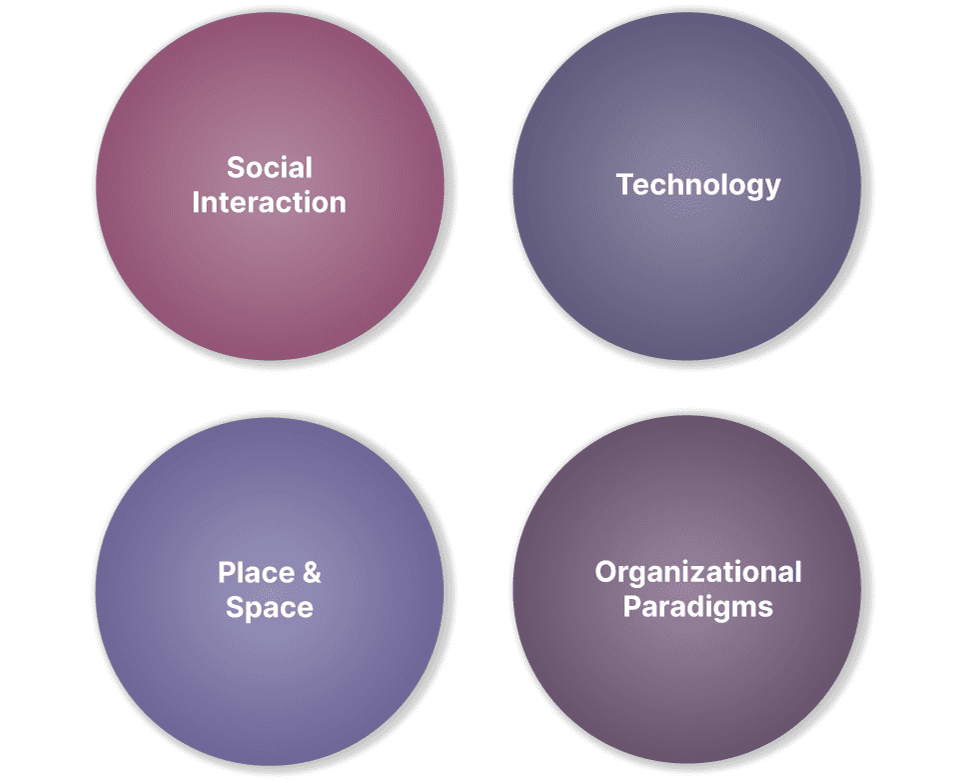
In a second evolution, a more holistic approach is taken, with conversations taking place not just around creating new buildings or providing new tech, but also how the nature of work is shifting. This includes challenging long-held and often non-negotiable assumptions around work. It might also mean revisiting the roles of managers and leaders. Still, many of the conversations happen in isolation, not connecting the dots due to not going deep enough. A practical example is organisations installing all the latest tech, which excites IT experts. But without adequate training to use the tech and to host differently, it leaves the meeting host feeling overwhelmed and prone to failure (i.e. a poor hybrid meeting experience).
3. Considering whole picture in workplace planning
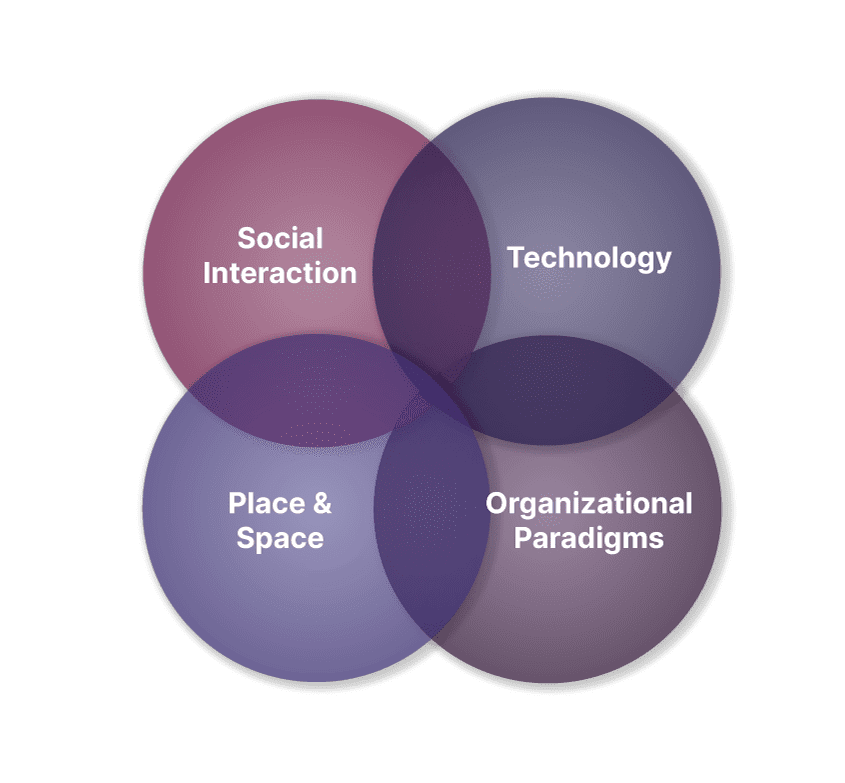
With further enlightenment, organisations start talking about the whole picture, understanding how the underlying elements of social interaction and organisational paradigms interplay with the elements on the surface (tech and place), and how each of these four elements mutually influence one another. And, what really seems to tick the needle, this includes engaging employees and their needs. A term often used to describe this engagement is ‘recontracting’, or re-negotiating the underlying contract. A practical example is to understand how the hierarchy is constantly reinforced by the way meetings are held. Managers must understand that they need to host meetings differently to honestly allow for the open sharing of different perspectives.
4. Evolving to a human-centered organisation
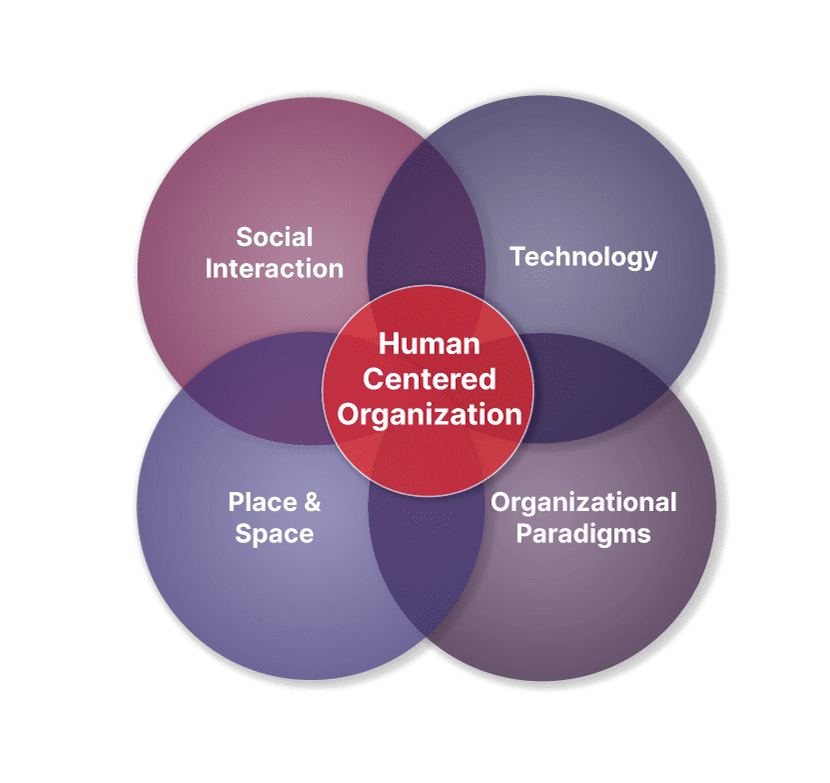
Regarding efforts to evolve ways of working and change behaviour to adopt a more human-centred approach, ET Group observes that it is much harder for large organisations to progress such discussions and make changes. More often, it is medium-sized and smaller organisations who are examining and evolving their ways of working—with a high correlation of eventually moving towards a more human-centred organisational paradigm.
From controlling to hosting
Summarising ET’s model, Dirk Propfe believes that ‘placing all the emphasis on technical sound and vision – important as those are – without considering issues of social interaction and organisational paradigms, could be holding companies back.
Stephan Berchtold provides an example: ‘If we look at managers, we see that many try to have the same kind of meeting they had before, the only difference being that part of the team is now remote. Even if tech and place allow for a high-quality experience, it still misses the point. The difference comes from the approach taken: do you want to control the meeting or host it? Unless you change the design of the meeting to host instead of control, it will be hard to include participants and create digital equality.’
Berchtold adds: ‘Let’s just take the conversations organisations have with their employees. Do they have parent-child conversations or are these adult-to-adult interactions? The invitation to participate on a level playing field is linked to psychological comfort at work. Currently, too many workers don’t feel psychologically safe and when hybrid meetings misfire, they are like the canary in the coalmine – they tell stories about things going wrong inside your organisation. ’
Consequences of poor meetings
The consequences for companies of a poor hybrid meeting experience are significant. ET Group has observed that, in the short term, it might be individuals and teams that suffer due to inefficiencies that obstruct project milestones. But in the longer term, the organisation itself begins to suffer as internal culture fragments, identity weakens and business clients are lost.
Dirk Propfe offers a quick test: ‘Just have a look at how many of the remote participants have their camera off, and then count those onsite who are distracted with their smartphone. This gives you a quick measure of inclusion and engagement.’
A poor hybrid meeting experience can mean several things for employees: take, for instance, the loss of control over contribution and influence, or a lack of respect they may experience. With regards to loss of control, this ties into WORKTECH Academy’s review of the academic literature in environmental and workplace psychology: having a sense of control and receiving positive messages of respect via the physical work environment are very important to worker performance and morale.
Consider the experience of people working mainly at home during the pandemic: Many had an upsurge in personal control over their environment. Urged to come back to the office, not only do employees feel excluded from decisions that impact the way they work, but they also experience a loss of control over their environment.
Add to this the fact that, in many organisations, meeting practices have not evolved yet. A bad hybrid meeting experience can easily contribute to the feeling of not being seen, not being included, not being valued. The pain points of the hybrid workplace are reinforcing this sentiment of disenchantment. Dirk Propfe observes that ‘the more of a sense of control you feel that you have, the more autonomy, flexibility and courage you have’.
ET Group’s message is that the issue of meeting equality is not independent from what’s going on beneath the surface of the company. While the technical and spatial aspects of hybrid meetings matter, the beliefs that underpin the structure of an organisation – those organisational paradigms – and the associated behaviours that align with those ways of thinking are perhaps what matter most.
According to ET Group’s Colby Harder, some clients learn from their struggles with hybrid meetings while others resist: ‘If they insist it won’t work, then it really won’t work’.
In a next article we will cover more on the role of social interactions and organisational paradigms as well as some tips for practical application. Read that article here: The barriers to hybrid collaboration that sit beneath the surface
ET Group is a Corporate Member of WORKTECH Academy. This article is the first in a series on hybrid meetings and the search for digital equality. The Four Pillars model has been developed by ET Group based upon its own experience transforming into a highly innovative and highly distributed team for nearly a decade. ET is now sharing the strengths and challenges of its distributed hybrid work experience with clients through programs and workshops. One of the workshops will be offered in cooperation with WORKTECH Academy on August 23, 2023.
Complaining about Status Quo Vs. Grumbling about ET Group Doing Something Unique
The following contains excerpts from an article written by Commercial Integrator. Click here to read the full article.
If you’ve read about the unique approach to business ET Group has taken for the past couple of years, chances are you’ve wondered—and possibly asked someone else—why it would do things that way.
Why would CEO Dirk Propfe transform his company to allow any employee to make decisions for the company, no matter how big or small they are?
Why would ET Group allow employees to name their own salaries after a year with the company?
And why would they allow employees to essentially job-hop within the company structure, a move they call “energizing roles?”
We also took a closer look at some of the recent worst examples of retail stores that maybe should have hired another AV integrator—if they hired one in the first place—to help them add new technology to their stores in an age where customers need to be captivated rather than turned away by failing tech.
We even let our resident Millennial web editor take a stab at rewriting some of our headlines in the style made popular by Buzzfeed in an attempt to show you how things could look on CI in an alternate universe.
Click here to read the full article





